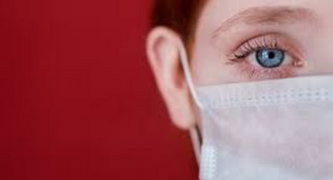
An expert in aerosol processes, Richard Flagan is the Irma and Ross McCollum-William H. Corcoran Professor of Chemical Engineering and Environmental Science and Engineering. He uses advanced instruments to study the chemistry and movement of tiny particles and droplets suspended in the air, which are called aerosols.
That focus gives him a unique perspective to evaluate how well masks work to prevent the transfer of COVID-19 viral particles from person to person through the air.
Here, as part of Conversations on COVID-19, a webinar series hosted by the Caltech Science Exchange, Flagan answers questions from the public, submitted during the December 2020 webinar.
The questions and answers below have been edited for clarity and concision.
What has your research found about the effectiveness of different types of commercially available masks?
We found that there is a great variability in masks.
The cloth masks are moderately effective. Good cloth masks will remove about two-thirds of the particles that you might inhale. There are others that will pass through 90 percent. You can tell, for some by inspection, that they will pass particles through. If you can see through them, they’re not doing a very effective job.
The pleated masks are designed so that they can be expanded, remaining somewhat narrow around the sides, but giving a larger area to cover the nose and the chin so that they restrict the airflow. There are many different varieties. Some of the pleated masks will remove particles with much better than 90 percent efficiency. But you can’t tell by looking at them which is which. Look for masks that are certified by some standard.
An N95 has on its outside surface an indication of who made it and that it’s been certified according to the standards. If you buy a mask that claims to be an N95 mask and it doesn’t have that, it’s not. If you buy one that has ear loops that claims to be an N95 mask, it’s not. The N95 masks use bands around the head in order to give a more secure fit.
There’s also the KN95. This is a Chinese standard. A KN95 stamp is a clear indication of the specific standard. They are efficient in the material sense… Because the KN95 doesn’t have any special sealing and it has ear loops, which are not very effective, I tend to use a very simple fix, a slip knot that I can pull tight to make it a little bit tighter on my face.
All masks only work if you’re protecting the entire route by which particles can go in or out. That means they have to cover and seal around the nose and the mouth. For men, if you have a beard, you’ve provided a leakage path.
If we know scientifically that a cloth mask doesn’t work as well as an N95, is it still worth wearing a cloth mask, and why?
If you’re wearing a good cloth mask, you’re reducing your exposure by about two-thirds. You’re reducing your dose to one-third of what it would be without the mask. If the person near you is also wearing a mask, they’re reducing the amount they’re emitting by the same factor. So if you have one-third protection for you and one-third protection from emission, multiply those together, and you’ve got down to about a 10 percent probability. You’ve reduced your exposure by a factor of 10.
Wearing a well-fitting KN95, a pleated mask, or a good cloth mask is great because the N95s are in very short supply, and the people who are on the front lines are putting their lives at risk to protect us. We really owe it to them to allow them to have that supply.
There are a lot of different kinds of masks out there, and you’re armed with a lot more knowledge than most people from your research. What would your ideal mask look like? What would its essential features be?
It would use a high-efficiency filtration medium. But it would probably not be made entirely from that. Just yesterday there was a discussion of establishing new standards for masks that are made of rubbery polymers that would then have separate filters. I think that is likely to be what we will end up with. If we look worldwide — and we need to address this problem not just in the U.S. but in the entire world if we want to get this pandemic fully under control — we’ve got to figure out ways to provide protection to people in areas where they don’t have the wealth to purchase elaborate masks. And for that, it may be something as simple as a piece of high-quality filter medium held in place by a frame that pulls it tight against the face and is shaped to fit over the areas where you get leakage. I think there are likely different solutions for different regions, but we really need to address the problem, not just in the U.S., but also globally.
Do you have any suggestions for active people who run or bike outside? What options are there for people who exercise, as far as masks for protecting yourself and others?
Wearing a mask is very important. There’s a peloton that goes by my house every Sunday morning, a large number of cyclists one right after the other, riding in each other’s wake.
Most are without masks and they’re breathing in what the people in front of them are emitting. And when they’re exercising hard, they’re breathing hard and that’s increasing the emission. So you’re increasing your intake and you’re also increasing your output. …You have to be able to breathe. Having a good quality mask would make sense. Definitely, you want something that’s going to stop the strong wind in your face, the effect from increasing your intake of the big particles. Probably the KN95 is the way to go at this point.
Have you found anything in your research about cleaning different kinds of masks, and how many times they can be worn?
I have not yet found anything about the number of times you can wash cloth masks. We have not tested long enough to see the degradation in the fabric. The woven fabric has holes that, as you wash it, lose some of the fine fibers that are actually doing the filtration, while the fine fibers that are twisted into threads are much less effective. You may find that it’s degrading with time.
There’s one way to clean disposable masks that has been approved for the N95 masks, and that is to use vapor-phase hydrogen peroxide, which would be very dangerous to breathe. Beyond that, there are a lot of other attempts to deactivate virus on masks. None of them have proven effective without degrading the masks.
Washing the nonwoven masks tends to degrade the material and, in particular, the N95 masks are built with charge stored in the mask. When you wash them, you wash away that charge and that dramatically decreases the efficiency. As you wear the mask, you deposit oils from your face that put moisture into it. It gradually degrades.
We have done tests on masks that have been worn several days. With the KN95 masks, we have found that after about four days, the efficiency of the masks decreases, and the pressure drop increases so they become less comfortable.
Do you think that masks will still be necessary after we get the vaccine?
I think they will be necessary for some time after we get the vaccine. How long that will be is a wide-open question. We don’t know what the sources are. We don’t know if someone who has been vaccinated and is then exposed to the virus would have some low-grade infection perhaps and be emitting virus, but not showing symptoms. We already know there are people who have the infection and don’t show symptoms. I would strongly support wearing masks.
The following are some of the other questions addressed in the video linked here: https://youtu.be/JHE9DuIjdg4
- Do masks also work for cold, flu, etc.? And if so, why hasn’t the U.S. adopted masks before? Did you ever wear a mask to prevent flu or anything like that before this pandemic?
- If you put one of the pleated masks with ear loops on and then you put a cloth mask over that, are the results are almost as good as an N95?
- Can you briefly explain what you mean when you say that mask has a built-in charge?
- With COVID-19 being so highly contagious, why aren’t used masks considered hazardous material to be disposed of?
- There’s been a lot of advice for people to wash their hands regularly; is there any value in washing your face after being out in public?
- If my mask is wet from perspiration and exhalation, does it still work? Has your lab tested the effect of humidity on masks?
- I have noticed many people wearing masks no longer feel they need to social distance. How can you assess the risk of exposure?
- Can you talk a little bit about the effectiveness of wearing a face mask and then wearing a face shield above the face mask?
- Are portable air purifiers with HEPA filters effective for removing COVID-19 virus in the air of your home?
This article was reviewed by a member of Caltech’s faculty.














 0 comments
0 comments


